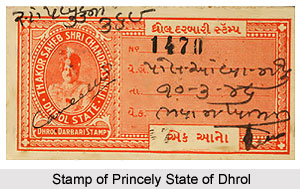 The Princely State of Dhrol was one of the well known 9 gun salute states of India that was administered by a native prince under the guidance of the British authorities. The princely state was under the indirect control of the British Empire in India. Dhrol State covered a total area of 283 sq m and comprised of a total population of 33,617 in the year 1941. It incorporated around 71 villages and was located in the northwestern Kathiawar. The region was an enclave within Nawanagar and comprised of a central block of territory and 6 distinctive exclaves. The state of Dhrol was bounded by Khirasra in the south. It was bordered by various other states and small talukas in the eastern and western parts.
The Princely State of Dhrol was one of the well known 9 gun salute states of India that was administered by a native prince under the guidance of the British authorities. The princely state was under the indirect control of the British Empire in India. Dhrol State covered a total area of 283 sq m and comprised of a total population of 33,617 in the year 1941. It incorporated around 71 villages and was located in the northwestern Kathiawar. The region was an enclave within Nawanagar and comprised of a central block of territory and 6 distinctive exclaves. The state of Dhrol was bounded by Khirasra in the south. It was bordered by various other states and small talukas in the eastern and western parts.
The Princely State of Dhrol was under the administrative control of the Baroda Agency and Western India States Agency. Later it became a part of the state of Gujarat. The territory was honoured as a salute state of India with a gun salute of 9 guns. The native ruler, also called Indian princes by the British authorities, held the title of Thakor Saheb and exercised extensive civil and criminal jurisdictional powers. He also managed and administered the internal affairs of the state. Dhrol paid annual tribute to the princely state of Baroda and the princely state of Junagadh. It was an erstwhile Second Class state which ranked 15th in order of precedence among the states of Western India, which lied between Limbdi and Palitana. The Thakor Saheb of Dhrol was an original member of the Chamber of Princes in his own right.
History of Princely State of Dhrol
The Jadeja Rajputs was the ruling family of the princely state of Dhrol. Hardolji, who was the brother of first Jam of Nawanagar, Jam Rawal, founded the state in the year 1539. Dhrol state was the second class state in the region of Saurastra. Prior to the advent of the Jadeja Rajputs, the territory was as Dhamalpur, which was ruled by Chavda King, known as Dhamal Chavda. He hindered the conquests of the Jam and in order to eradicate such obstacles, Jam Hardholji marched against the ruler Dhamal Chavda. His army consisted of various warrior tribes such as Solanki, Khimsurya, Dabhi, Makwana, Varsur, Gohil, Jhala, Jadav, Chauhan, Rathod and Chavda. But as the different clans were not united, they were defeated and the Jadejas killed Dhamal Chavda in 1539 AD.
During the reign of the British East India Company, the state was appointed as a princely state under the supervision of the Jadeja dynasty. The state was granted a 9 gun salute status and privy purse of a huge sum. In the year 1947, the last ruler His Highness Thakore Saheb Shri Chandrasinhji Dipsinhji Jadeja, who was the 20th of his line, acceded his state to the newly formed Union of India, also known as Dominion of India on 15 February 1948.
Rulers of Princely State of Dhrol
The chronology of the native rulers of the princely state of Dhrol is listed below-
* Thakore Saheb Hardholji Lakhaji
* Thakore Saheb Jasoji Hardolji
* Thakore Saheb Bamanyanji Jasoji
* Thakore Saheb Hardholji Bamanyanji Ii
* Thakore Saheb Modji Hardholji
* Thakore Saheb Kaloji Panchanji
* Thakore Saheb Kaloji Panchanji
* Thakore Saheb Junoji Kaloji
* Thakore Saheb Ketoji Junoji
* Thakore Saheb Kaloji Ketoji
* Thakore Saheb Waghji Ketoji
* Thakore Saheb Jaysinhji Waghji
* Thakore Saheb Junoji Ii Jaysinhji
* Thakore Saheb Nathoji Junoji
* Thakore Saheb Modji Nathoji
* Thakore Saheb Bhupatsinhji Modji
* Thakore Saheb Jaisinhji Bhupatsinhji
* Thakore Saheb Hamirisinhji Jaisinhji
* Thakore Saheb Dolatsinhji Hamirsinhji
* His Highness Thakore Saheb Shri Jorawarsinhji Dipsinhji Saheb
* His Highness Thakore Saheb Shri Chandrasinhji Dipsinhji Saheb



















